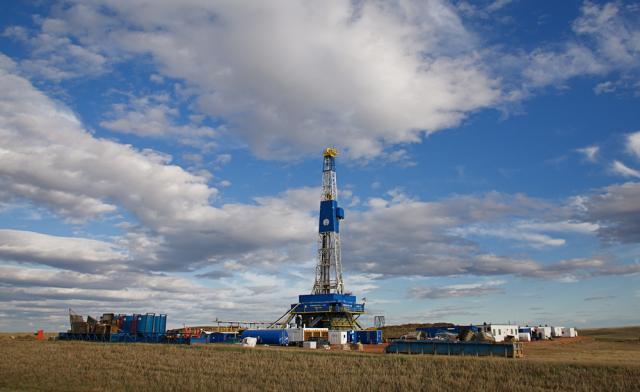
An oil rig is shown near Williston, North Dakota. Continental Resources is among the top oil producers in the Bakken. (Source: Tom Reichner/Shutterstock.com)
The performance of a trio of step-out wells drilled by Continental Resources Inc., one of the biggest oil producers in the U.S., has again proven that optimized completion designs are working in the Bakken.
“As expected these three wells are outperforming nearby legacy wells by 80% to 110% during the first 60 days and preliminary estimates show these wells are delivering up to 100% rates of return,” Jack Stark, the company’s president, said on an earnings call April 30. “This is great news for our shareholders as we can confidently say that the value and performance of our inventory of approximately 4,000 Bakken wells continues to grow. We can also say that the core of the Bakken … just got bigger.”
Two of the wells, both in North Dakota, recorded 24-hour IPs of at least 2,400 barrels of oil equivalent per day (boe/d), while a third—in Montana—flowed 1,680 boe/d.
The wells were drilled in the far western and southern parts of the company’s legacy Bakken acreage. So “we feel good that the areas in between are going to respond,” Stark said, noting Continental is also pushing farther north.
This comes as the company moves deeper into multizone unit development across its vast oil-rich Bakken acreage, having already completed nearly 200 optimized developed wells since early 2017.
Completion designs for the three step-outs varied based on the area, but the company said it essentially used closer perf cluster spacing and more stages and proppant than it has used historically in the areas.
Oil and gas companies in prominent shale plays across the U.S. have been tweaking completion recipes as they continue to improve well performance in hopes of adding value.
“Although E&P operational updates tend to be less impactful than they used to be, investors should pay close attention to [Continental’s],” Barclays analysts said in an April 30 note.
The analysts turned to Continental’s “strong” free cash flow (FCF) story and low corporate breakeven driven by the Bakken. “Because the Bakken is the more understood driver of FCF, incremental data points in the newer Scoop Springboard play are key to gaining confidence in [Continental’s] nearer-term oil/FCF growth story,” Barclays said.
RELATED: Continental Raises 2019 Cash Flow Outlook On Higher Oil Prices
But analysts dinged the company for its capex miss.
First-quarter 2019 capex of $750 million missed Barclays/Street consensus estimates of between $700 million and $705 million vs. previous management commentary of about $670 million, Barclays said. The analysts also noted Continental completed eight net wells and spud six net wells extra during the quarter.
Continental attributed the higher than planned capex to improved cycle times and efficiency gains.
The company reported April 29 that its overall production jumped 16% in the first quarter to 332,236 boe/d compared to a year earlier. Most of that growth came from the Bakken, where production rose 24% to 199,423 boe/d.
Oklahoma’s Scoop production, home to the Project SpringBoard development, increased 9% to an average 67,659 boe/d.
RELATED: Continental Resources’ SpringBoard Remains On Track To Grow Oil Production
SpringBoard production is already exceeding expectations. Continental projects production here could hit 18,000 boe/d in the third quarter, thanks to improved drilling, cycle times and well performance.
“Production for the first 28 days of April has averaged approximately 14,000 net barrels of oil per day, only 2,500 barrels shy of the 16,500 barrels of oil per day we had been targeting by the third quarter,” Stark said.
SpringBoard Woodford completions averaged about 1,660 boe/d—75% oil. Progress is also being made by Springer wells.
“We have drilled 25 of the 31 Springer wells planned for rows 2 and 3 and completion work is underway,” Stark added. “We expect to have results from rows 2 and 3 by our next earnings call. But I can say that early rates from a couple of wells that just started flowing back look solid.”
In all, 39 wells are currently producing at the SpringBoard development, 33 wells are undergoing completion and nine rigs are drilling ahead. Improved cycle times enabled the company to operate with 25% fewer rigs compared to last quarter, he said.
Velda Addison can be reached at vaddison@hartenergy.com.
Recommended Reading
Humble Midstream II, Quantum Capital Form Partnership for Infrastructure Projects
2024-01-30 - Humble Midstream II Partners and Quantum Capital Group’s partnership will promote a focus on energy transition infrastructure.
GE Vernova Completes Spin-Off from GE
2024-04-04 - GE Vernova, an energy transition company, began trading as an independent company on the New York Stock Exchange this week.
Bobby Tudor on Capital Access and Oil, Gas Participation in the Energy Transition
2024-04-05 - Bobby Tudor, the founder and CEO of Artemis Energy Partners, says while public companies are generating cash, private equity firms in the upstream business are facing more difficulties raising new funds, in this Hart Energy Exclusive interview.
Mexico Pacific Appoints New CEO Bairstow
2024-04-15 - Sarah Bairstow joined Mexico Pacific Ltd. in 2019 and is assuming the CEO role following Ivan Van der Walt’s resignation.
NOV's AI, Edge Offerings Find Traction—Despite Crowded Field
2024-02-02 - NOV’s CEO Clay Williams is bullish on the company’s digital future, highlighting value-driven adoption of tech by customers.






